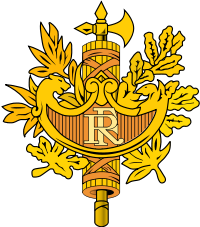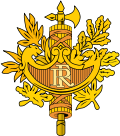- National emblem of France
-
Emblem of the French Republic 
Details Armiger The French Republic Adopted 1912 (1953) Escutcheon A shield at the corners of the head of a lion and an eagle with the monogram RF, standing for République française. A shield is placed on a fasces with crossed laurel branch and an oak branch all or. The current emblem of France has been a symbol of France since 1953, although it does not have any legal status as an official coat of arms. It appears on the cover of French passports and was adopted originally by the French Foreign Ministry as a symbol for use by diplomatic and consular missions in 1912 using a design by the sculptor Jules-Clément Chaplain.
In 1953, France received a request from the United Nations for a copy of the national coat of arms to be displayed alongside the coats of arms of other member states in its assembly chamber. An interministerial commission requested Robert Louis (1902–1965), heraldic artist, to produce a version of the Chaplain design. This did not, however, constitute an adoption of an official coat of arms by the Republic.
Technically, it is an emblem rather than a coat of arms, since it does not respect heraldic rules—[citation needed]heraldry being considered an aristocratic art by the French government,[citation needed] and therefore associated with the Ancien Régime. The emblem consists of:
- A wide shield with, on the one end a lion-head and on the other an eagle-head, bearing a monogram "RF" standing for République Française (French Republic).
- A laurel branch symbolises victory of the Republic.
- An oak branch symbolises perennity or wisdom.
- The fasces, a symbol associated with justice (the bundle of rods and an axe, carried by Roman lictors). This use of the fasces predates the adoption of this symbol by Benito Mussolini as the emblem of Italian Fascism.
In September 1999, the French government adopted a unique official identifier for its communication, incorporating the Republic's motto, the colours of the flag, and Marianne, the Republic's personification.[1]
Contents
History
Coat-of-Arms Description Dates Used 
The France Ancien. Before 1305 
The France Ancien dimidiated with the arms of Navarre, used by Kings Louis X and Charles IV. 1305–1328 
The France Ancien. 1328–1376 
The France Moderne, a simplified version of the France Ancien reduced the number of fleur-de-lys to three. 1376–1515 
The France Moderne, now showing a closed royal crown. 1515–1589 
The royal arms of the Kingdom of France after the conclusion of the French Wars of Religion. Again the arms of the Kingdom of Navarre impaled with the France Moderne, indicating the personal union of the two realms as a result of Henry IV becoming king. 1589-1792 
Unofficial
Emblem of the Napoleonic Consulate used by Napoleon Bonaparte as First Consul during the French First Republic featuring an imperial eagle holding a lighting bolt with laurel leaves and the letter N in the centre.1799–1804 
The arms of the First French Empire of Napoleon I, featuring an eagle and inset with "golden bees" as in the tomb of King Childeric I. 1804–1814 
After the restoration the royal house of Bourbon once more assumed the French crown. These arms are still used by the royal house of France. 1814–1830 
During the July Monarchy the arms of the House of Orléans were used. 1830–1831 
During the July Monarchy the arms of Louis-Philippe were used, depicting the Charter of 1830. 1831–1848 
The arms of the Second French Empire of Napoleon III, again featuring an eagle 1852–1870 
Unofficial
Informal arms were created for the French Third Republic featuring fasces on a laurel branch and an oak branch in saltire.1898–1953 
Unofficial
Emblem of Philippe Pétain, chief of state of the French State (Vichy France), featuring the motto Travail, Famille, Patrie (Work, Family, Fatherland). The Francisque was only Pétain's personal emblem but was also gradually used as the regime's informal emblem on official documents[2]1940–1944 
Unofficial
Informal arms dating from 1912, reintroduced during the presidency of Jacques Chirac (1995–2002) and still used.1995–present See also
References
- ^ Service d'Information du Gouvernement (24 September 1999). "Charte Graphique de la Communication Gouvernementale" (PDF). http://www.emploi.gouv.fr/boite_outils/_cd_charte_graph/dossier%20compatible/charte%20com%20gouvernementale.pdf. Retrieved 23 October 2011.
- ^ « Cachet de la sous-préfecture de Dinan, 6 décembre 1943, État français (Régime de Vichy) » , Académie de Rennes.
External links
Symbols of the French Republic Coats of arms of Europe Sovereign
statesAlbania · Andorra · Armenia · Austria · Azerbaijan · Belarus · Belgium · Bosnia and Herzegovina · Bulgaria · Croatia · Cyprus · Czech Republic · Denmark · Estonia · Finland · France · Georgia · Germany · Greece · Hungary · Iceland · Ireland · Italy · Kazakhstan · Latvia · Liechtenstein · Lithuania · Luxembourg · Macedonia · Malta · Moldova · Monaco · Montenegro · Netherlands · Norway · Poland · Portugal · Romania · Russia · San Marino · Serbia · Slovakia · Slovenia · Spain · Sweden · Switzerland · Turkey · Ukraine · United Kingdom (England • Northern Ireland • Scotland • Wales) · Vatican City
States with limited
recognitionAbkhazia · Kosovo · Nagorno-Karabakh · Northern Cyprus · South Ossetia · Transnistria
Dependencies
and other territoriesÅland · Faroe Islands · Gibraltar · Guernsey · Jan Mayen · Jersey · Isle of Man · Svalbard
Categories:- National emblems
- National symbols of France
- French coats of arms
Wikimedia Foundation. 2010.


